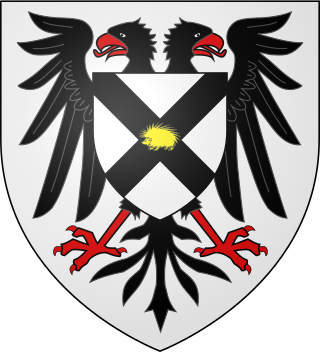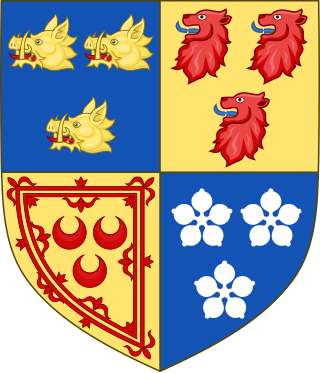Related Research Articles
James Hamilton, 1st Earl of AbercornPC (S) (1575–1618) was a Scottish diplomat for James VI and an undertaker in the Plantation of Ulster, Ireland.

Duke of Hamilton is a title in the Peerage of Scotland, created in April 1643. It is the senior dukedom in that peerage, and as such its holder is the premier peer of Scotland, as well as being head of both the House of Hamilton and the House of Douglas. The title, the town of Hamilton in Lanarkshire, and many places around the world are named after members of the Hamilton family. The ducal family's surname, originally "Hamilton", is now "Douglas-Hamilton". Since 1711, the dukedom has been held together with the Dukedom of Brandon in the Peerage of Great Britain, and the dukes since that time have been styled Duke of Hamilton and Brandon, along with several other subsidiary titles.
William Sinclair (1410–1480), 1st Earl of Caithness (1455–1476), last Earl (Jarl) of Orkney, 2nd Lord Sinclair and 11th Baron of Roslin was a Norwegian and Scottish nobleman and the builder of Rosslyn Chapel, in Midlothian.

The Mormaer or Earl of Buchan was originally the provincial ruler of the medieval province of Buchan. Buchan was the first Mormaerdom in the High Medieval Kingdom of the Scots to pass into the hands of a non-Scottish family in the male line. The earldom had three lines in its history, not counting passings from female heirs to sons. Today, it is held by the Erskine family as a peerage. The current holder is Harry Erskine, 18th Earl of Buchan.

Earl of Elgin is a title in the Peerage of Scotland, created in 1633 for Thomas Bruce, 3rd Lord Kinloss. He was later created Baron Bruce, of Whorlton in the County of York, in the Peerage of England on 30 July 1641. The Earl of Elgin is the hereditary Clan Chief of Clan Bruce.

Lord Lovat is a title of the rank Lord of Parliament in the Peerage of Scotland. It was created in 1458 for Hugh Fraser by summoning him to the Scottish Parliament as Lord Fraser of Lovat, although the holder is referred to simply as Lord Lovat. It was a separate title from the Scottish feudal lordship of Lovat, already held by the highland Frasers. In 1837 they were created a third title, Baron Lovat, of Lovat in the County of Inverness, in the Peerage of the United Kingdom. The holder is separately and independently the Chief of the highland Clan Fraser of Lovat.

Earl of Nithsdale was a title in the Peerage of Scotland. It was created in 1620 for Robert Maxwell, 9th Lord Maxwell, with remainder to heirs male. He was made Lord Maxwell, Eskdale and Carlyle at the same time. The title of Lord Maxwell had been created in the Peerage of Scotland in 1445 for Herbert Maxwell.

John Douglas, 2nd Earl of Morton died 9 September 1513 at the Battle of Flodden.

Earl of Kilmarnock was a title created twice in the Peerage of Scotland for the Boyd family. It was first created in 1454 for Robert Boyd, Great Chamberlain of Scotland. It was created a second time in 1661 for William Boyd, 10th Lord Boyd. Both titles were forfeited in 1746.
Robert Boyd, 4th Lord Boyd was a Scottish nobleman who supported various factions attempting to dominate Scottish politics during the reign of King James V and the minority of Mary, Queen of Scots.

Sir James Balfour Paul was the Lord Lyon King of Arms, the officer responsible for heraldry in Scotland, from 1890 until the end of 1926.

Sir John Keith, 1st Earl of Kintore PC (Scot), was a Scottish nobleman.
Lord Innermeath is an extinct title in the Peerage of Scotland created c. 1471 for Walter Stewart, 1st Lord Innermeath. Stewart had previously been Lord of Lorne, but resigned that title - which came with substantial comital power - under pressure from James III; James wished to weaken the remaining power of the Black Douglases, who had been allies of Walter's uncle, The Black Knight of Lorn. Walter had in fact held the Lordship of Lorne for only a few days, following the murder of his brother, the former Lord of Lorne.
The Stewart, later Shaw-Stewart Baronetcy, of Greenock and Blackhall in the County of Renfrew, is a title in the Baronetage of Nova Scotia. It was created on 27 March 1667 for Archibald Stewart. In Scotland, the name is styled Shaw Stewart. This family is descended in the direct male line from Sir John Stewart, illegitimate son of Robert III of Scotland, who granted him the estate of Ardgowan in Renfrewshire. The third Baronet married Helen, sister and co-heir of Sir John Houston of that Ilk, 4th Baronet, and his wife Margaret, daughter of Sir John Shaw, of Greenock, 2nd Baronet. The fourth Baronet succeeded to the Greenock estates on the death of his great-uncle Sir John Shaw of Greenock, 3rd and last Baronet, in 1752 and assumed the additional surname of Shaw. He later sat as Member of Parliament for Renfrewshire from 1780 to 1783 and from 1786 to 1796.

Alexander Seton, 1st Earl of Huntly, who adopted the family name of Gordon from about 1457, was a powerful 15th-century Scottish magnate. He was knighted in 1439/1440 and was Lord of Badenoch, Gordon, Strathbogie and Cluny.

The Scots Peerage is a nine-volume book series of the Scottish nobility compiled and edited by Sir James Balfour Paul, published in Edinburgh from 1904 to 1914. The full title is The Scots Peerage: Founded on Wood's Edition of Sir Robert Douglas's Peerage of Scotland, containing an Historical and Genealogical Account of the Nobility of that Kingdom.
John Ross, 2nd Lord Ross of Halkhead was a Scottish nobleman.
William Ross, 10th Lord Ross of Halkhead, was a Scottish nobleman.
William Ross, 14th Lord Ross of Halkhead, was a Scottish nobleman.
Dunbar Hamilton Douglas, 4th Earl of Selkirk FRSE was a Scottish peer.
References
Notes
Sources
- Balfour Paul, Sir James, The Scots Peerage IX vols, Edinburgh 1904.
- Lyle, Wm. (1936). "De Insula" or The Lyles of Renfrewshire.